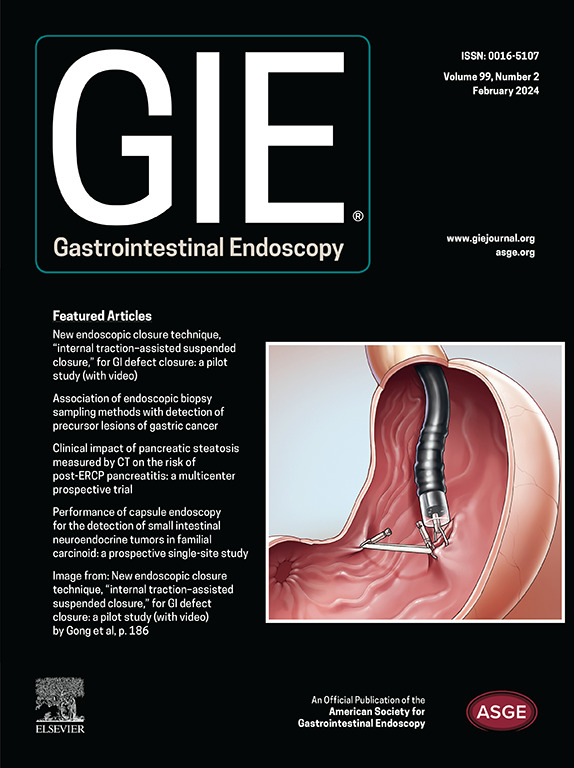提高胶囊内镜可视化和诊断率的准备方案(PrepRICE);一项多中心随机试验。
IF 6.7
1区 医学
Q1 GASTROENTEROLOGY & HEPATOLOGY
引用次数: 0
摘要
背景和目的:现行指南建议在进行小肠胶囊内镜检查(SBCE)前进行肠道准备。然而,最佳方案尚未确定。为了确定 SBCE 准备的最佳时机,我们比较了四种镇痛方案的小肠可视化质量(SBVQ)、诊断率(DY)和患者报告的结果:在这项前瞻性、随机(1:1:1:1:1)、多中心研究中,疑似小肠出血患者被随机分为四组:G1(SBCE 前一晚使用 1 升聚乙二醇 + 抗坏血酸 [Moviprep®])、G2(SBCE 前 2 小时内,早上使用 1 升)、G3(SBCE 前 2 小时内使用 0.5 升 + 胶囊到达十二指肠后使用 0.5 升)和 G4(SBCE 到达十二指肠后使用 1 升)。为了评估 DY,病变被分为高出血潜能(P2)或低出血潜能(P0 或 P1)。小肠可视化质量(SBVQ)采用布罗兹评分法进行评估。测量转运时间(TT),患者耐受性从 0 到 5 分,分数越高耐受性越好:共纳入 387 名患者;59% 为女性,中位年龄为 73 岁(IQR 23)。G1组的检查完成率较低(90%,p结论:在 SBCE 前一天晚上接受肠道准备的一组患者的治疗效果较差。术中清肠疗法可降低 SBTT、增强可视性、改善 DY 并提高血管扩张的检出率。G4 是耐受性最好的方案。本文章由计算机程序翻译,如有差异,请以英文原文为准。
Preparation Regimens to Improve Capsule Endoscopy Visualization and Diagnostic Yield (PrepRICE): a multicenter randomized trial
Background and Aims
Current guidelines recommend bowel preparation before small-bowel capsule endoscopy (SBCE). However, the optimal protocol is yet to be defined. To determine the best timing for preparation in SBCE, we compared small-bowel visualization quality (SBVQ), diagnostic yield (DY), and patient-reported outcomes across 4 purgative regimens.
Methods
In this prospective, randomized (1:1:1:1), multicenter study, patients with suspected small-bowel bleeding were randomized into 4 arms: G1 (1 L of polyethylene glycol + ascorbic acid [Moviprep, Norgine, Amsterdam, The Netherlands] the night before SBCE), G2 (1 L in the morning up to 2 hours before SBCE), G3 (0.5 L up to 2 hours before SBCE + 0.5 L after the capsule reached the duodenum), and G4 (1 L after the capsule reached the duodenum). To assess DY, lesions were categorized as having high (P2) or low (P0 or P1) bleeding potential. SBVQ was assessed using the Brotz score. Transit times were measured, and patient tolerability was scored from 0 to 5, with higher scores indicating better tolerability.
Results
A total of 387 patients were included, 59% female and with a median age of 73 years (interquartile range, 23). The examination completion rate was lower in G1 (90%, P < .001). Small-bowel transit time was shorter for patients receiving purgative during SBCE (G3 and G4, P = .001). SBVQ was better in patients receiving purgative after reaching the small bowel (P < .001): a median of 7 for G1, 8 for G2, and 9 for G3 and G4. The overall DY of patients receiving intraprocedure purgatives (G3 + G4) was superior (42.7 vs 31.3%, P = .02); significant differences were found in the second and third terciles. Likewise, G3 and G4 had higher angioectasia detection (P = .04). Patients’ satisfaction was significantly superior for G4 (median, 4 points; interquartile range, 1).
Conclusions
The group that received the bowel preparation the night before SBCE had poorer outcomes. Intraprocedure purgative regimens reduced SBTT, enhanced visualization, improved DY, and increased angioectasia detection. G4 was the best-tolerated regimen.
求助全文
通过发布文献求助,成功后即可免费获取论文全文。
去求助
来源期刊

Gastrointestinal endoscopy
医学-胃肠肝病学
CiteScore
10.30
自引率
7.80%
发文量
1441
审稿时长
38 days
期刊介绍:
Gastrointestinal Endoscopy is a journal publishing original, peer-reviewed articles on endoscopic procedures for studying, diagnosing, and treating digestive diseases. It covers outcomes research, prospective studies, and controlled trials of new endoscopic instruments and treatment methods. The online features include full-text articles, video and audio clips, and MEDLINE links. The journal serves as an international forum for the latest developments in the specialty, offering challenging reports from authorities worldwide. It also publishes abstracts of significant articles from other clinical publications, accompanied by expert commentaries.
 求助内容:
求助内容: 应助结果提醒方式:
应助结果提醒方式:


